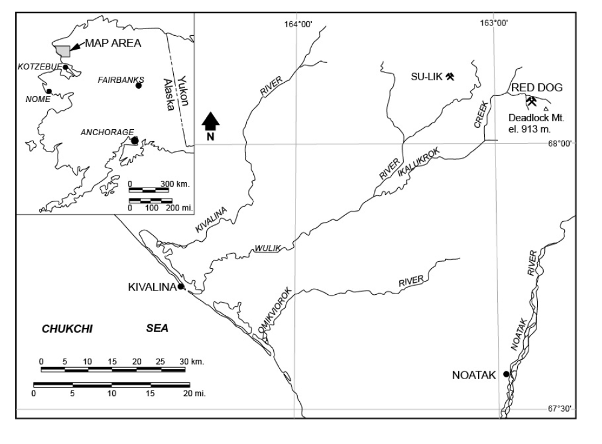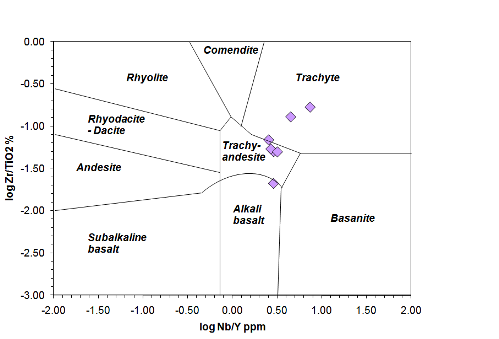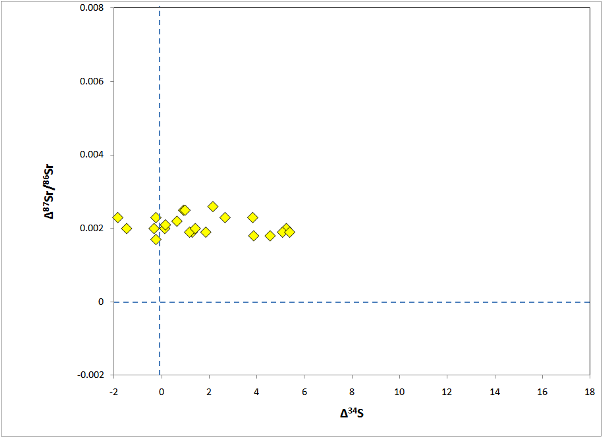Hydrothermal barite - Red Dog
Red Dog, in northern Alaska, is one the world's largest Pb-Zn producers. It is operated by Teck Cominco, and has been studied by many geologists, especially from the U.S. Geological Survey (see 2004 special issue of Economic Geology).

The Red Dog orebodies are hosted by Carboniferous sediments that in the Mesozoic were deformed into a set of imbricate thrust sheets. At the time of mineralization, the district was undergoing extension that produced north to northwest-trending grabens. One of these was the Kuna Basin, estimated to have been 200 by 600 km. It contains at most only 360 m of deep-water sediment accumulated over 30 million years. This starved shale basin was rimmed by carbonate platforms.
Mudstone Host
The Kuna Formation is a slope and basin deposit comprising laminated black shales, carbonate turbidites, and black cherts. In its lower part, the Kivalina unit, shale alternates rhythmically with limestone turbidites on a centimeter to meter scale. The overlying Ikalukrok unit contains a lower portion comprising well-laminated, sooty, organic-rich black shales with some limestone turbidites and an upper portion comprising medium-bedded black chert. The overlying Siksikpuk Formation is also a chert and shale unit, but the dark colors of the Kuna Formation are replaced by green-gray and maroon.

For the environment of deposition of the ores, a major question is the degree of oxygenation of the bottom water of the basin during the accumulation of these sediments. Was bottom-water anoxia a factor in the generation and preservation of the ore bodies? That is, was the basin euxinic, with H2S in the bottom water that would have served to preserve the sulfides, or was the bottom water oxygenated? Detailed geochemical analyses of unmineralized Kuna Formation rocks by Slack et al. (2004a; 2004b; data files) indicate the presence of anoxic conditions within the sediment, but not in the bottom water. Evidence includes:
- total sulfur averages less than 1 %,
- plots of organic C vs total S show a broad correlation passing through the origin,
- molybdenum is low: Mo/Ti x 104 = 65 compared to > 600 for euxinic basin shales
- pyrite framboids are relatively large, 7 to 10 μm, compared to 4 to 6 μm found in euxinic sediments
Volcanic Rocks
Volcanic rocks have not been described at Red Dog, but are well-developed in the related Drenchwater Creek prospect (Werdon, 1996). The associated volcanic rocks are about 100 m thick and yield K-Ar ages of 319+/- 10 Ma, consistent with the Mid- to Late Mississippian age of the Kuna sediments, but likely a few million years younger than the main stage of mineralization at Red Dog. The volcanics are dominantly submarine tuffaceous rocks, comprising light gray, medium to coarse grained, porphyritic felsic tuffs. Almost all samples show extensive alteration and major element chemistry has been reset (loss-on-ignition values range from 2 to 8 %). Immobile trace elements show a strong enrichment in Nb relative to Y that is consistent with alkaline volcanism in an extensional tectonic setting:

Isotopes
The barite at Red Dog contains a variety of sulfide minerals in addition to BaSO4. Consequently, sulfur isotopes can be used to help characterize the various stages of mineralization. Galena + sphalerite contain sulfide sulfur that covers the same span of δ34S values as pyrite + marcasite, but averages -2.7 ‰, whereas disulfide sulfur averages -8.5 ‰ (data file). This difference between pyrite and the ore-stage sulfides indicates that much of the pyrite formed by normal bacterial sulfate reduction in the sediment before mineralization, but other pyrite has the ore-stage signature, and some biogenic sulfide was incorporated in galena and sphalerite. Sulfate sulfur for the barites averages about +17 ‰, indicating an unmodified seawater source for this sulfur.
Sr isotopes of barite, on the other hand, are somewhat radiogenic, averaging 0.70963, compared to Mississippian seawater at 0.7076. Therefore, some Sr was contributed by rocks underlying the deposit as well as from seawater. Ba presumably had the same sources.

Ore Deposits Home |
Barite references |
Site Map |
|---|